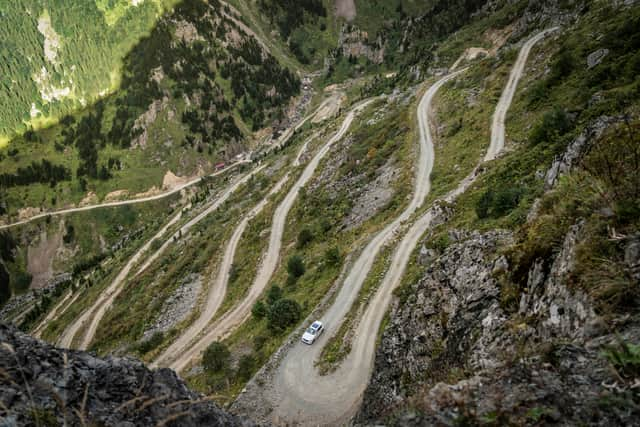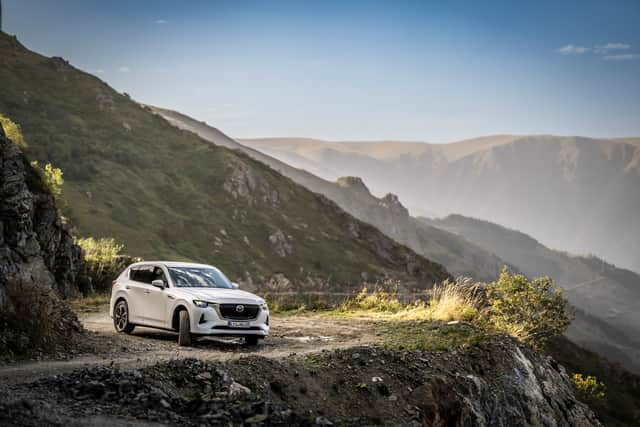Living on the edge: dicing with death on some of the world’s most dangerous roads
and live on Freeview channel 276
“Don’t stand too close to the edge. I’m being serious; not too close.”
Those words from cameraman Dave Smith, reassuringly advised at a height of around 8,000ft, are still ringing in my ears after conquering two of the most dangerous roads in the world: the daunting Derebasi Curves on Turkey’s challenging D915, and the iconic, dramatic Stone Road.
Advertisement
Hide AdAdvertisement
Hide AdBoth roads are difficult places to access geographically: the former stretches south from close to Trabzon in Turkey’s north-easternmost corner, sitting on the shores of the Black Sea; and the Stone Road runs north out of Kemaliye on the D877 deep in Central Turkey.
So, when Mazda came knocking on the door and asked whether I’d be up for the challenge — tackling two of the most dangerous roads in the world over 48 hours, and covering more than 1,100km, much of it on gravel, narrow single-track roads — how could I say no? Plus they were letting me loose in the Japanese carmaker’s first plug-in hybrid, the CX-60.


After flying into Istanbul, I caught a 90-minute flight to Trabzon, a city whose existence I’d only previously associated with its football team Trabzonspor; having reached the Champions League group stages in 2011/12, it most recently won the Turkish league in 2021/22.
It’s not a place commonly visited by Europeans. In fact, staying in a hotel which is part of a multinational chain I was informed my small group of eight UK journos were the first Europeans to stay this year. This is not a European holiday destination. Bizarrely the most common visitors are from Saudia Arabia: and apparently they visit to experience the rain.
Advertisement
Hide AdAdvertisement
Hide AdNo coincidence then that as I set out at 8am at the start of day one from the centre of Trabzon, it was pouring rain. Not the weather I wanted.
Why? Because I knew the Derebasi Curves are treacherous in dry conditions. In the wet they are almost impassable. Located near the town — I say town, but essentially it’s a small cluster of houses — of Caykara, the Curves are a series of 13 incredible hairpins which wind steeply up the single gravel track cut into the mountainside from an elevation of 5,617ft above sea level, to 6,677ft.


Health and safety? You’re having a laugh. There’s no protection on the road. Crash barriers? Forget it. You make a mistake anywhere on the road — especially at a few of the hairpins which are so tight you need to turn in, reverse, then complete the manoeuvre forwards before continuing your climb skywards — and you’re literally careering down the mountainside to your fate.
I’d checked the forecast for the day. I was hopeful that as my drive towards the Derebasi Curves continued, the weather on the other side of the mountains would improve.Once out of Trabzon, the D915 soon becomes unpaved. Sure it starts and finishes on asphalt, but it’s the bit in the middle where the real challenge is. It climbs, and climbs, and climbs. Even at its early stages it’s not for the faint-hearted, with almost every corner bordered by dangerous drop-offs and steep falls.
Advertisement
Hide AdAdvertisement
Hide AdSoon the road became tighter. In a left-hand drive CX-60, even close to the walls on my left-hand side, if I peered out of the passenger-side window there was no sign of the road surface below me. Just a drop. A long drop to the valley far below.
Having negotiated the opening 800-metres into the first really narrow section, I came across my first challenge. Coming towards me was a local in a very large minibus. He wasn’t for moving. It was up to me to reverse. No probs: I could do that.


Checking my rear-view mirror, I engaged reverse gear and inched backwards. Then, round the corner comes a local delivery driver. Boy, this is fun. Thankfully he realised he had no alternative but to reverse. I followed suit, determined to show I’m not fazed by the massive drop on my right-hand side.
After 200-or-so metres, we found a slightly wider section which allowed me to steer to the right-hand side of the minibus as it slowly inched past me on my left. It resembled a sort of painfully slow ’Strictly’ dance move choreographed by two drivers, one of whom was making his debut in the event. Thankfully when the score boards were shown I got a full display of 10s.
Advertisement
Hide AdAdvertisement
Hide AdBuoyed by my success, I continued rising through the valley before seeing the satnav display a graphic which looked like a medical illustration of someone’s intestines. That was the Derebasi Curves.
Rising steeply above me, they were, unquestionably challenging. Sure they’re not for the inexperienced driver. Nor the location to discover you suffer from vertigo. But given the fact the weather was now dry, though the fog was rolling in, the Derebasi Curves were drivable. Game. On.


In fact they reminded me instantly of driving the Pass of the Cattle, the historic single-track mountain pass which rises through the mountains of the Applecross peninsula in Wester Ross in the Scottish Highlands.
The secret to conquering both: stay focused; don’t drive too fast; be sensible; and, most importantly, definitely most importantly, don’t look down.
Advertisement
Hide AdAdvertisement
Hide AdThe big CX-60 rose to the challenge, always remaining surefooted. Though the occasional scramble of loose gravel under the Mazda as I negotiated the tightest of corners was an instant reminder that this was no Sunday afternoon drive.
Once at the top, just below the now foreboding cloud level, from my vantage point I could look down over the Curves. Gosh the track looked narrow, especially in the context of seeing another car coming up it. And the view back north, up the valley I’d driven, was spectacular. An ever narrowing sinew of gravel track receding into the distance as it meandered down the facing mountainside.